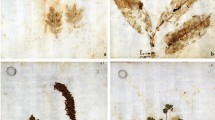Abstract
Economic Botany 58(Supplement):S280–S293, 2004. This study examines the adaptation and evolution of the Hawaiian ethnopharmacopoeia looking specifically at the inclusion of recently introduced plants in the pharmacopoeia as recorded within ethnobotanical studies from 1838–2002. Generally, the number of native plants (both indigenous and endemic) recorded in ethnobotanical studies decreases over time, while the number of recently introduced plant increases. This study lists the recently introduced plants, the date they were first recorded as part of the ethnophar-macopoeia, and their place of origin. It also discusses some of the possible factors influencing the inclusion of new plants in the Hawaiian medical tradition, building on and adding to the current work on the origin of Polynesian herbal medicine.
Similar content being viewed by others
Literature Cited
Abbott, A. I. 1984. Limu: An ethnobotanical study of some Hawaiian seaweeds. Pacific Tropical Botanical Garden, Lawai.
— 1999. Marine red algae of the Hawaiian Islands. Bishop Museum Press, Honolulu.
—, and C. Shimazu. 1985. The geographic origin of the plants most commonly used for medicine by Hawaiians. Journal of Ethnopharmacology 14:213–222.
Barrau, J. 1963. Plants and migrations of Pacific peo ples: A symposium. Bishop Museum Press, Honolulu.
Bennett, B. C., and G. T. Prance. 2000. Introduced plants in indigenous pharmacopoeias. Economic Botany 54(1):90–102.
Chun, M. N. 1986. Hawaiian medicine book: He buke la’au lapa’au. Translated. Bess Press, Honolulu.
Cox, P. A. 1991. Polynesian herbal medicine. Pages 147–168 in P. A. Cox and S. A. Banack, eds., Islands, plants, and Polynesians: An introduction to Polynesian ethnobotany. Dioscorides Press, Portland.
Davis, W. 1995. Ethnobotany: An old practice, a new discipline. Pages 40–51 in R. E. Schultz and Siri von Reis, eds., Evolution of a discipline. Dioscorides Press, Portland.
George, L. O. 1989. An ethnomedical study of tradi tional medicine in Tonga. M.S. dissertation, Dept. of Botany and Range Science, Brigham Young University-Provo.
Gutmanis, J. 1976. Kahuna la’au lapa’au: The practice of Hawaiian herbal medicine. Island Heritage Press, Honolulu.
Handy, E. S. C, M. K. Pukui, and K. Livermore. 1934. Outline of Hawaiian physical therapeutics. Bishop Museum Bulletin 126. Krauss Reprints, Honolulu.
Harris, D. R. 1998. Introduction: The multi-disciplinary study of cross-cultural plant exchange. Pages 85–91 in H. D. V. Prendergast, N. L. Etkin, P. R. Harris, and P. J. Houghton, eds., Plants for food and medicine. Royal Botanical Gardens, Kew.
Johns, T. 1990. The origin of human diet and medicine: Chemical ecology. University of Arizona Press, Tucson.
Judd, N. L. K. M. 1997. Laau lapaau: A geography of Hawaiian herbal healing. Thesis for the degree of Doctor of Philosophy (University of Hawaii at Manoa). Geography; no. 3483.
Juvik, S. P., and J. O. Juvik. 1998. Atlas of Hawaii. 3rd ed. University of Hawaii Press, Honolulu.
Kamakau, S. M. 1964. Ka po’e kahiko, the people of old. Translated M. K. Pukui. Bishop Museum Press. Special Publication 51, Honolulu.
Krauss, B. H. 1979. Native plants used as medicine in Hawaii. Lyon Arboretum, Honolulu.
— 1993. Plants in Hawaiian culture. University of Hawaii Press. Honolulu.
— 2001. Plants in Hawaiian medicine. Bess Press, Honolulu.
Malo, D. 1971. Hawaiian antiquities: Moolelo Hawaii, 2d ed. Translated Nathaniel B. Emerson. Bishop Museum Special Publications 2, Honolulu.
Paul, A. 2002. Origins of the Haitian ethnopharmacopoeia. PhD. dissertation (Ecology, Evolutionary and Conservation Biology) Columbia University, New York.
Prance, G. T., and V. Plana. 1998. The use of alien plants in tropical South American folk medicines. Pages 185–200 in H. D. V. Prendergast, N. L. Etkin; P. R. Harris, and P. J. Houghton, eds., Plants for food and medicine. Royal Botanical Gardens, Kew
Ragone, D. 1991. Ethnobotany of breadfruit in Poly nesia. Pages 203–220 in P. A. Cox and S. A. Banack, eds., Islands, plants, and Polynesians: An introduction to Polynesian ethnobotany. Dioscorides Press, Portland.
Rivera, D., and C. Obon. 1995. The ethnopharmacolgy of Madeira and Porto Santo Islands, a review. Journal of Ethnopharmacology 46:73–93.
Stone C. P., and J. M. Scott. 1985. Hawaii’s terrestrial ecosystems: Preservation and management: Proceedings of a symposium held June 5–6, 1984 at Hawai’i Volcanoes National Park. Honolulu, Cooperative National Park Resources Studies Unit, University of Hawaii.
Valier, K. 1995. Ferns of Hawaii. Univeristy of Hawaii Press, Honolulu.
Wagner, W. L., D. R. Herbst, and S. H. Sohmer. 1999. Manual of flowering plants of Hawaii. Volumes 1 and 2. Revised Editions. Bishop Museum Press and University of Hawaii Press, Honolulu.
Whistler, W. A. 1992. Polynesian herbal medicine. National Tropical Botanical Garden, Lawai.
Wright, T. 1972. The disenchanted isles: The story of the second revolution in Hawaii. The Dial Press, New York.
Yen, D. E. 1991. Polynesian cultigens and culivars: The question of origin. Pages 67–96 in P. A. Cox and S. A. Banack, eds., Islands, plants, and Polynesians: An introduction to Polynesian ethnobotany. Dioscorides Press, Portland.
Author information
Authors and Affiliations
Rights and permissions
About this article
Cite this article
Palmer, C.T. The inclusion of recently introduced plants in the Hawaiian ethnopharmacopoeia. Econ Bot 58 (Suppl 1), S280–S293 (2004). https://doi.org/10.1663/0013-0001(2004)58[S280:TIORIP]2.0.CO;2
Received:
Accepted:
Issue Date:
DOI: https://doi.org/10.1663/0013-0001(2004)58[S280:TIORIP]2.0.CO;2




